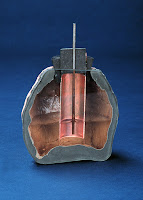If you have been there, you would not be surprised.Going Down: Climate change, water use threaten Lake Mead
If climate changes as expected, and future water use goes unchecked, there's a 50 percent chance that Lake Mead—one of the southwestern United States' key reservoirs—will become functionally dry in the next couple of decades, a new study suggests.

Besides providing water for millions, flow from Lake Mead—the reservoir formed as the Colorado River collects behind Hoover Dam—generates prodigious amounts of hydroelectric power. Over the past century, on average, about 18.5 cubic kilometers of water flowed into Lake Mead each year, says Tim P. Barnett, a climatologist at the Scripps Institution of Oceanography in La Jolla, Calif. Of that amount, about 2.1 km3 evaporate into the dry desert air or soak into the ground beneath the lake each year. What's left in the lake is more than spoken for: The amount of water drawn from Lake Mead this year to meet demand in cities as far-flung as Los Angeles and San Diego will exceed 16.6 km3.
And the situation will likely get worse, Barnett and colleague David W. Pierce speculate in an upcoming Water Resources Research. By 2030, the researchers note, annual demand for Lake Mead's water is projected to rise to 17.4 km3. Also, some climate studies suggest that the Colorado's flow will drop between 10 and 30 percent in the next 30 to 50 years. Using these data, as well as weather simulations that impose random but reasonable annual variations in river flow volume, Barnett and Pierce used a computer model to estimate the remaining useful life of the Lake Mead reservoir.
Thanks in part to the worst drought in the Southwest in the past 500 years (SN: 6/26/04, p. 406), Lake Mead is now at about 50 percent capacity. If current allocations of water persist, there's a 50 percent chance that by 2023 Lake Mead won't provide water without pumping, and a 10 percent chance that it won't by 2013. Moreover, there's a 50 percent chance that Hoover Dam won't be able to generate power by 2017, the researchers estimate.
"We were stunned at the magnitude of the problem and how fast it was coming at us," says Barnett.
Results of the new study are "fairly provocative, an eye-opener," says Connie Woodhouse, a climatologist at the University of Arizona in Tucson. Using estimates of river flow based on an average of the past century may be optimistic, she adds, because tree ring–based reconstructions of the region's climate suggest that the 20th century was one of the wettest in the past 500 years. "The more we learn about the Colorado River and its hydrology, the more worried we need to be," says Peter H. Gleick, a hydrologist at the Pacific Institute in Oakland, Calif.
http://www.sciencenews.org/articles/20080223/fob2.asp















